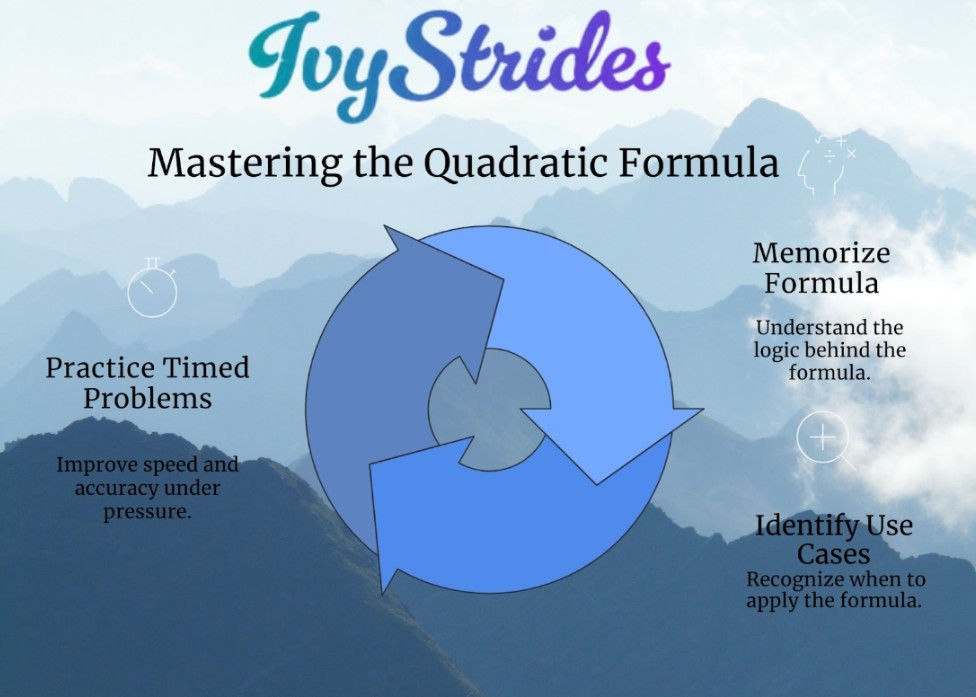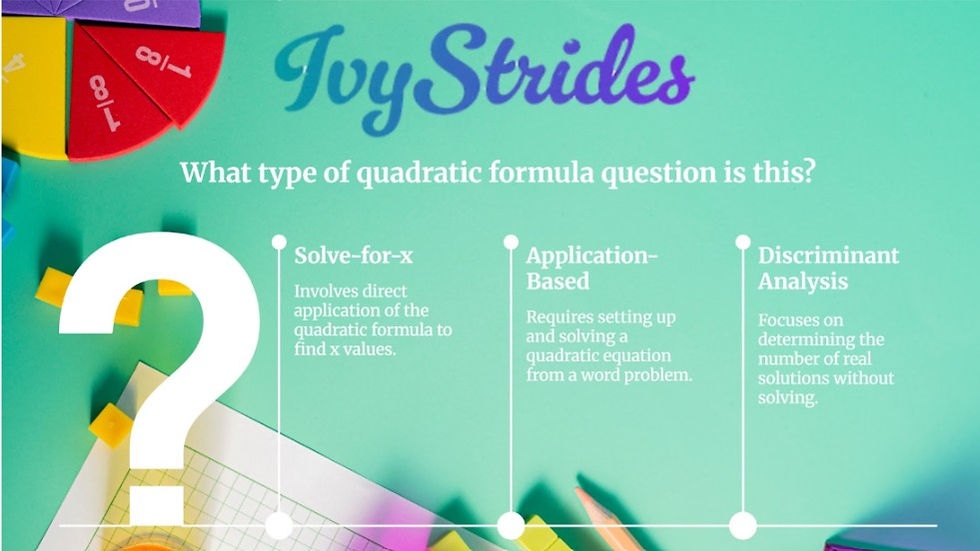This One Mistake in the Quadratic Formula Could Cost You 50 SAT Points
- Hemant Attray
- 3 days ago
- 8 min read

If you’re preparing for the SAT, chances are you’ve seen the quadratic formula a dozen times. It looks simple enough, just plug in the values of a, b, and c, and solve. But here’s the catch: one tiny mistake with this formula can cost you up to 50 points.
At IvyStrides, we’ve worked with hundreds of students who know the quadratic formula by heart, but still miss crucial SAT points because of how they use it. And we’re not talking about rare, complex errors. We’re talking about a straightforward mistake, a tiny sign slip, a wrong substitution, or a misread discriminant that can easily cost you 30 to 50 points on test day.
The good news? It’s 100% fixable. In this post, we’ll walk you through the most common quadratic formula error, show how it affects your SAT score, and give you simple tools to catch it before it costs you. You’ll also get expert strategies, real SAT examples, and free practice support, straight from our IvyStrides classroom.
Ready to never miss those points again? Talk to Our SAT Counsellors
Understanding the Quadratic Formula Before the SAT
The quadratic formula is one of the most dependable tools for solving second-degree equations on the SAT.
Anytime you’re asked to solve something like:
ax² + bx + c = 0
You’ll use this standard formula:
x = (-b ± √(b² - 4ac)) / 2a
Here’s how it works, step by step:
a, b, and c are the numbers you pull directly from the equation.
The ± (plus-minus) means you’ll usually get two answers, one with a plus, one with a minus.
The part under the square root b² - 4ac is called the discriminant. It tells you whether the solutions will be real, repeated, or complex.
The square root helps determine the exact values for the equation’s roots.
The 2a in the denominator ensures everything is divided correctly.
It might look long, but once you understand how each piece fits, it becomes one of your most powerful SAT math tools.
Want more SAT-style math examples like this? Download free worksheets from our SAT resource library and try solving them with a timer just like the real exam.

Using the Discriminant to Predict the Nature of Roots
One of the smartest things you can do on SAT math? Use the discriminant to figure out what kind of answer you’ll get before doing all the calculations.
Here’s the shortcut:
If b² - 4ac > 0, you get two real roots
If b² - 4ac = 0, you get one real root
If b² - 4ac < 0, the roots are imaginary
We teach you to use the discriminant as a decision tool, saving time, avoiding unnecessary steps, and choosing more competent answers faster.
Visualizing the Quadratic Formula in Action
When you use the quadratic formula, you’re not just solving an equation; you’re finding out where a parabola hits the x-axis. That’s what the solutions (also called roots) really are: the x-values where the expression equals zero.
Let’s break it down simply:
If the graph crosses the x-axis twice → two real roots
If it just touches the x-axis once → One real root
If it misses the x-axis altogether → No real roots, just imaginary ones
The Most Common Mistake in the Quadratic Formula And How They Appear in the Actual SAT
Most students don’t lose SAT math points because they forgot the quadratic formula; they lose them because they misuse it.
Let’s break down the most common mistakes we see:
Misplacing the Negative Sign on 'b'
Here’s the classic slip-up:
You’re solving:
x² + 4x - 5 = 0a = 1, b = 4, c = -5
But instead of correctly writing: x = (-4 ± √(4² - 4 × 1 × -5)) / 2 × 1
You accidentally write:x = (4 ± √(4² - 4 × 1 × -5)) / 2
That missing negative at the front changes your answer completely. What’s worse? The wrong answer is usually right there in the multiple-choice options, waiting for you to pick it.
Confusion in the Discriminant
The discriminant, b² - 4ac, decides whether your answer is real, repeated, or imaginary. But it’s also a danger zone.
Misplacing parentheses, squaring a negative incorrectly, or forgetting to multiply the whole term can quickly give you the wrong root type. Worse, it can lead you to eliminate the right SAT answer because it “looks wrong.”
At IvyStrides, we show students how to slow down in the right places, not everywhere, just where accuracy counts most.
We drill this repeatedly in our SAT online classes, so by the time students face the real test, this step is second nature.
How the Mistake Appears in Actual SAT Quadratic Questions
The SAT is clever. It doesn't just ask you to plug values into the quadratic formula; it sets traps for minor sign errors or rushed simplifications.
Question Formats That Expose Errors
Here’s where the most common mistake shows up:
Multiple-choice traps that include the answer you'd get if you forgot the negative sign on “–b”
Grid-in questions where there's no process of elimination, just you and your math
Application problems tied to motion, geometry, or age-related scenarios where the quadratic setup isn’t obvious.
The No-Calculator Section
When the SAT takes away your calculator, the slightest mistake becomes costly. The quadratic formula may still show up here, especially in questions with clean square roots like 4 or 9. You’ll be expected to:
Work with perfect squares confidently
Simplify correctly, especially the denominator
Choose between positive and negative solutions based on context
That’s why we focus so much on clarity and confidence in this formula, especially for no-calculator questions.
How to Use the Quadratic Formula Like a Pro (Even Under Pressure)
Knowing the quadratic formula is one thing. Using it quickly, accurately, and confidently during the SAT? That’s a skill.

Here’s how to make it second nature, no matter how nervous or rushed you feel on test day.
1. Memorize the Formula
Yes, you need to remember:
x = (-b ± √(b² - 4ac)) / 2a
But don’t just memorize the letters. Learn how the logic flows. Knowing what each part means helps you avoid careless mistakes and gives you a speed edge.
2. Know When to Use It (And When Not To)
Sometimes factoring or completing the square is faster than doing whole calculations.
Use the formula when:
The equation can’t be factored easily
You’re given tricky coefficients or decimals
You’re solving word problems or application-based questions
Learn how to spot these scenarios by checking out our SAT math strategy blog.
3. Practice With Timed Problems
Knowing the formula doesn’t help if you freeze when the clock’s ticking. That’s why timed drills matter. When you use the quadratic formula strategically, you’ll find that it’s not just a solution method; it’s a time-saving, stress-reducing advantage on test day.
Our SAT practice tests include quadratic formula problems under test-like conditions so that you can build accuracy and speed together.
IvyStrides Strategy to Avoid the Quadratic Formula Mistake
At IvyStrides, we’ve seen this mistake trip up even top students.
That’s why we created a checklist to lock in your accuracy:
Identify a, b, and c clearly from the standard form ax² + bx + c = 0
Use parentheses around “–b” to preserve the sign during substitution
Simplify the discriminant first before tackling the square root
Don’t skip the ± step—it’s the only way to get both solutions
Divide only after simplifying the square root and the entire numerator
Mnemonic That Makes It Stick
Here’s a fun and memorable line we teach our students:
Negative Boy Couldn't Decide To Go To A Party. He Missed 4 Awesome Chicks.
It encodes the formula:-b ± √(b² – 4ac) / 2a
Download our Cheat Sheet so you never forget the step, and Join Our SAT Prep Classes.
Quadratic Formula Questions You’ll Actually See on the SAT
The SAT doesn’t just test whether you’ve memorized the quadratic formula; it checks if you can apply it correctly under pressure.

That’s why understanding the type of questions you’ll face makes all the difference.
1. Classic Solve-for-x Questions
These are straightforward: you're given an equation like:
2x² - 3x - 5 = 0
And you're asked to find the values of x. You’ll plug a = 2, b = -3, and c = -5 into the formula and solve.
2. Application-Based Word Problems
Example:
A ball is launched from the ground with an initial velocity. Its height in meters after t seconds is modeled by: h(t) = -5t² + 20t
What is the time when the ball hits the ground?
You set h(t) = 0 and solve the quadratic:
-5t² + 20t = 0 → t(-5t + 20) = 0 → t = 0 or t = 4
3. Disguised Discriminant Questions
Some SAT questions don’t ask you to solve at all, just to analyze the number of solutions.
Example:
How many real solutions does x² + 4x + 5 = 0 have?
Use the discriminant:b² - 4ac = 16 - 20 = -4
Negative means: no real solutions. Know the three possibilities for b² - 4ac so you can answer in seconds.
Need to sharpen these skills before your test date? Our SAT study guide walks you through every math concept with examples, strategies, and downloadable practice.
How IvyStrides Coaching Helps Catch Quadratic Formula Mistakes Early

When students join IvyStrides, we immediately start looking for patterns, including that one sneaky quadratic formula slip.
Here’s how we do it:
Diagnostic assessments flag early signs of misunderstanding
Small-group sessions allow instructors to spot subtle errors in real time
Performance analytics track if a student repeatedly gets the sign or discriminant wrong
Immediate feedback helps fix the mistake before it becomes a habit
We don’t just grade answers; we read the process.
Conclusion: Don’t Let One Quadratic Formula Mistake Cost You 50 Points
The quadratic formula is one of the most potent tools in SAT math - but it only works when used with care. One small sign error, one misstep in the discriminant, and that’s 30 to 50 points off your score.
But now you know exactly what to watch for and how to fix it before test day.
At IvyStrides, we’ve helped thousands of students master this formula and avoid costly mistakes. You don’t have to figure it out alone.
Join a Free Demo Class and work through real SAT math problems with us.
FAQs: Quadratic Formula & SAT
Do I need to memorize the quadratic formula for the SAT?
Yes. The SAT does not provide the quadratic formula in its formula sheet. Memorization is essential, especially for the no-calculator section.
What if the quadratic formula gives an imaginary number on the SAT?
While imaginary roots aren’t tested heavily, you may still encounter them. Understanding what a negative discriminant means helps you quickly eliminate wrong options.
Can the quadratic formula be used for all quadratic equations on the SAT?
Yes, but sometimes other methods, like factoring or completing the square, are faster. Knowing when to use the formula is part of being SAT-ready.
Is it possible to get SAT questions wrong even after applying the quadratic formula correctly?
Unfortunately, yes. Most errors happen during simplification or plugging values into the formula. That’s why checking signs and parentheses is critical.
What’s the fastest way to solve quadratic equations on the SAT?
There’s no one-size-fits-all. But IvyStrides teaches how to choose the fastest method based on the equation’s structure: factoring, formula, or calculator shortcut.
Still have questions? Contact us




Comments